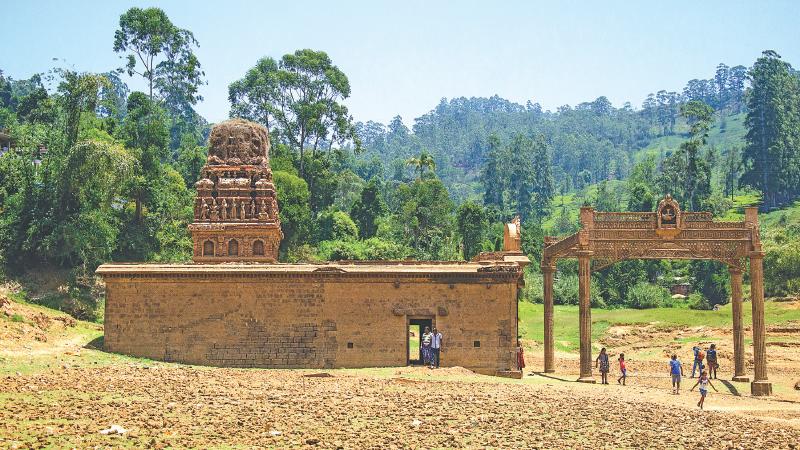
The famous re-surfaced Hindu temple in the dried up reservoir bed of Maussakele drew me to the once grand old town of Maskeliya and now a dusty town in a parched landscape.
 For someone who chases monuments and forgotten ruins across the dried up reservoir beds in the central hills, everything that the Maskeliya reservoir had to offer fascinated me.
For someone who chases monuments and forgotten ruins across the dried up reservoir beds in the central hills, everything that the Maskeliya reservoir had to offer fascinated me.
When my son told me about the Sri Kathireshan Hindu temple on the reservoir bed in Maussakele, I was most eager to visit it. People have been visiting this temple after it re-surfaced in the receding water level of the reservoir due to the prolonged drought in the area. It is one of the temples we re visited during our recent tour to Maskeliya.
 Although newspaper reports had alerted us about the receding water levels of the reservoirs, it is not new to us as we re-visited the cracked parched landscape of the reservoir bed, and found the most exquisite temple built in stone.
Although newspaper reports had alerted us about the receding water levels of the reservoirs, it is not new to us as we re-visited the cracked parched landscape of the reservoir bed, and found the most exquisite temple built in stone.
It was a small temple, and as the sun’s rays fell on it, the brick and cement Gopuram with the damaged carvings glowed, while the cloudless blue sky heated up the granite slabs.
Legend has it that the temple was built in the old Maskeliya town by the Hindu families who came from South India and settled down during the colonial period. The temple, said to have been built in 1917, under the guidance of South Indian sculptors, had belonged to a Hindu devotee in India.
However, not much is known about the builders of this 19th century Murugan temple called Sri Kathireshan Hindu temple. It has a Gopuram in the middle of the flat roof built with stone slabs, and under it is the sacred stone chamber where the statues of the Gods have been placed, and is considerably smaller than the rest of the building. Walking leisurely inside, between the granite columns, we came across spectacular ruins of stone carvings. The stone sculptured statues of Skanda or Murugan inside the stone covered chamber and other stone sculptured pillars with various floral motifs and mythical figures of animals adorned the square pillars of the temple.
Observing some intricately carved floral motifs on the stone doorframes, we didn’t see any vandalism caused to the temple, although it lay under water most of the time. However, a few stone slabs laid on the floor had been removed in some places and large quantities of mud alluvial deposited inside the temple. Nevertheless, the Hindu and Buddhist devotees faithfully worshipped at the temple.
It is a unique feature that the stone structure of the temple remains intact even after being submerged under water for more than 50 years. I realized that these sculptured pillars resemble those at the Gadaladeniya Vihara in Kandy. Coming out of the temple, we visited the concrete structure that has been badly damaged in the water and lay in ruins in front of the temple.
It is believed that there was a gate in front of the temple before it submerged in water as seen in the ruined four big concrete columns which stood with their damaged panels on the temple structure depicting religious and secular scenes, from Hindu Gods, and animal carvings.
The exquisite panel on the top depicts God Skanda with his vehicle, the peacock. A row of small mythical animals are also visible covered by remarkable cement carvings though the figures have been worn down over time.
The Sri Kathireshan temple, once a foremost Hindu religious monument worshipped by thousands of devotees in the old Maskeliya town, was inundated in the Maussakele reservoir when it was impounded in 1968 to produce hydro-electricity to the country.
When the Sri Pada season begins, most pilgrims journey through Maskeliya town and on their way back from the peak, they throng the reservoir bed of Maussakele to gaze leisurly at the religious monuments including the Sri Kathireshan temple.
The temple with its mythology, artistic perfection and message of communal harmony symbolizes Maskeliya. Although it is submerged under water most of the time in a year, decayed by the elements it can’t be preserved for the future and is fully lost to us. However, Hindus and Buddhists along with other minorities worship at the temple when it re-surfaces in the receding water level of the reservoir during drought.
